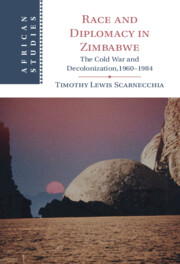Book contents
- Race and Diplomacy in Zimbabwe
- African Studies Series
- Race and Diplomacy in Zimbabwe
- Copyright page
- Contents
- Figures
- Acknowledgments
- Abbreviations
- Introduction
- 1 Historical Background
- 2 The Early 1970s
- 3 Liberation Struggles in Southern Africa
- 4 “We Don’t Give a Damn about Rhodesia”
- 5 Negotiating Independence
- 6 Negotiating Independently
- 7 The Big Gamble
- 8 The 1980 Elections and the First Years of Independence
- 9 Gukurahundi and Zimbabwe’s Place in the 1980s Cold War
- Conclusion
- Select Bibliography
- Index
- African Studies Series
9 - Gukurahundi and Zimbabwe’s Place in the 1980s Cold War
- Race and Diplomacy in Zimbabwe
- African Studies Series
- Race and Diplomacy in Zimbabwe
- Copyright page
- Contents
- Figures
- Acknowledgments
- Abbreviations
- Introduction
- 1 Historical Background
- 2 The Early 1970s
- 3 Liberation Struggles in Southern Africa
- 4 “We Don’t Give a Damn about Rhodesia”
- 5 Negotiating Independence
- 6 Negotiating Independently
- 7 The Big Gamble
- 8 The 1980 Elections and the First Years of Independence
- 9 Gukurahundi and Zimbabwe’s Place in the 1980s Cold War
- Conclusion
- Select Bibliography
- Index
- African Studies Series
Summary
This final chapter covers the events of 1983’s Gukurahundi operation, where Mugabe and his ruling party decided to launch the North Korean-trained Fifth Brigade against dissidents in Matabeleland North and South provinces and the Midlands province. Reports of their activities started to be known by the British military and then Anglo-American diplomats by mid-February. The reception of reports, particularly of large numbers of civilian deaths by the Fifth Brigade, is discussed in terms of Anglo-American diplomats. Different diplomatic responses between the Americans and the British to the Gukurahundi are examined, although both agreed to avoid making an international issue out of the reports of large numbers of civilian deaths in a concerted effort. Diplomatic debates over how much Prime Minister Mugabe was responsible are also discussed, as is Mugabe’s attempts to rationalize his use of the Fifth Brigade against civilians. The final discussion revolves around the use of “tribalism” or ethnic conflict by Anglo-American diplomats to help justify their lack of protest to civilian killings by a government that was also receiving development aid funding and military training and aid during this period.
Keywords
- Type
- Chapter
- Information
- Race and Diplomacy in ZimbabweThe Cold War and Decolonization,1960–1984, pp. 266 - 314Publisher: Cambridge University PressPrint publication year: 2021

